If you wanted to make a 1 horse power DC permanent magnet motor
for a bicycle what would be required?
Answer:
HP = 32572 Foot pounds of force per minute. (see Wiki for
HP)
A bicycle going at different speeds will have some revolutions
per minute. Assume rolling radius of tire is 13" (26" road
tire), Circumference of tire is 81.7" or 6.8'.
Speed Miles per Hour
|
10
|
20
|
30
|
Linear Speed Feet/min
=5280 ft/mi / 60 min/hr * Mi/hr
|
880
|
1760 |
2640 |
Rotational speed RPM
= Linear speed/6.8'
|
129
|
259
|
388
|
Pounds of force needed at 1 foot radius for
1 H.P.
=32572 / RPM
|
252
|
125
|
83
|
Force needed on one face of permanent
magnet
Pounds of force needed along circumference / 4
|
63
|
31
|
21
|
If the permanent magnets are arranged around the rear wheel so
that the polarity alternates (N, S, N, S, ...) Then an
electromagnet can be attracting one pm while repelling another
thus doubling the force. In a like manner if the
electromagnet in wound on an inverted "U" shape then each end of
the pm will be either attracted or repelled thus cutting the
force needed in half again.
The Rare Earth magnets (Wiki)
are currently the strongest yet economically practical so that's
what I'm going to be looking at. The
Neodymium (Wiki)
is the one most commonly used.
One source for these is K&J
Magnetics, they have a calculators
that will tell you about Pull Force, Repelling Force, Magnetic
Field, Plate Thickness & Field in a gap with or without a
yoke.
There are Wiki pages for: Magnetic
Force, Ampère's
force law, Magnetic
Constant (Vacuum
permeability µ0),
Note: I would expect that the magnetic field between a
couple of magnets (wither pm or em) would increase if a yoke
connected the back of each. This becomes more and more
important as the gap approaches zero length.
Older permanent magnets needed to be long and skinny in order
to have strength. You could think of a short and fat
magnet as made up of a bunch of long skinny magnets tied into a
bundle. But the modern rare Earth magnets can be very
strong even though they are short, like a coin with the poles as
the heats and tails.
One of the first uses for electromagnets was for telegraphy and self winding clocks
(1 & 2),
doorbells, phone ringers, etc.. In these applications two
side by side electromagnets had their cores connected together
by an iron strap leaving two pole pieces exposed to attract an
armature. These typically had soft iron cores, it was only
later that Silicon steel laminations were used to reduce losses.
The key equation is B = u0 * k * I * (N/L)
B = field (Tesla)
u0 = 4π×10−7 (N·A−2)
I = Current (Amps)
N/L = Turns per meter.
The N/L term may assume a single layer coil construction
rather than a multiple layer coil. That's because the
first layer encloses some area, but the next layer encloses a
larger area and so on for more layers where each successive
layer generates a weaker and weaker field.
Using a smaller wire diameter makes for a stronger field
(N/L) increases, but smaller wires can carry less
current. The total length of wire and so the voltage
drop across the coil (and the power dissipated in the coil)
are related to the diameter of the coil, so a smaller diameter
is desirable, i.e. only as big as needed.
Purdue College Lecture 8: A
Design Example - An Electromagnet.pdf, 60 pages
Tattoo Machine
While looking for low cost electromagnets I came across Tattoo
Machine Coils on eBay. The are labeled by the number of
"Wraps", which is Tattoo speak for what I'd call layers. I
ordered 8, 10 and 12 Wrap coils. Sold in pairs with a capacitor
for under $4 per pair, or under $2 per electromagnet.
Note that the capacitor is covered with black shrink tube so if
using the pair be sure to note polarity by means of the dimple
(see: Fig 2 and Fig 3).
Wraps
|
Ohms
(2 Coils)
|
Guess
Ft of Wire per coil1
|
|
8
|
2.7
|
53
|
|
10
|
3.7
|
73
|
|
12
|
4.0
|
|
|
Note 1: Resistance divided by 0.02567 mΩ/ft (from wire
table) divided by 2 for one coil.
12 Wrap Coil smaller than the 8 & 10 wrap coils.
Metal Core: not removable. 9mm OD, Length 31.0 mm, Mounting
Thread: TBD4x0.7mm,
Plastic Coil form: Flanges: 19 mm O.D., Height: 25mm, Winding
height: 225mm
8 Wrap & 10 Wrap Dimensions:
Metal Core: 7.8mm OD, Length 32.0 mm, Mounting Thread: 4x0.7mm,
no groove for a circlip ( Wiki)
Plastic Coil form: Flanges: 18.5 mm O.D., Height: 27mm, Winding
height: 25.75mm, Core hole: 8mm I.D. (too small for the 8.6 mm Tefenol-D rods)
Coil: Typically wound with 24 AWG enamel wire (Wiki):
AWG Wire Table
|
Diameter |
Turns of wire, without
insulation |
Area |
Copper wire |
| Resistance/length[7] |
Ampacity,[8]
at 20 °C insulation material temperature rating,
or for single unbundled wires in equipment for 16 AWG and
smaller[9] |
Fusing current[10][11] |
| 60 °C |
75 °C |
90 °C |
Preece[12][13][14][15] |
Onderdonk[16][15] |
| (in) |
(mm) |
(per in) |
(per cm) |
(kcmil) |
(mm2) |
(mΩ/m[a]) |
(mΩ/ft[b]) |
(A) |
~10 s |
1 s |
32 ms |
| 24 |
0.0201 |
0.511 |
49.7 |
19.6 |
0.404 |
0.205 |
84.22 |
25.67 |
3.5 |
2.1 |
- |
29 A |
62 A |
348 A
|
Tattoo Coil Photos
Fig 1: 8 Wrap & 10 Wrap pairs.
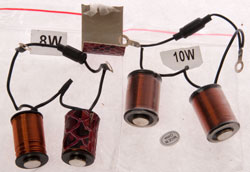
|
Fig 2 Note dimple on Capacitor = + End
 |
Fig 3 Note dimple on Capacitor = + End
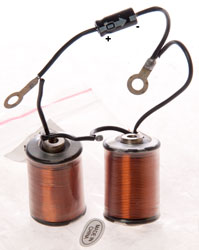 |
Fig 4 12 Wrap - Capacitor polarity unknown.
22 uF, 35 V, but polarity no clearly marked.
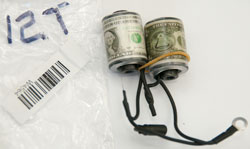
|
Fig 5 Looks like the same size wire, but
with a shorter winding length
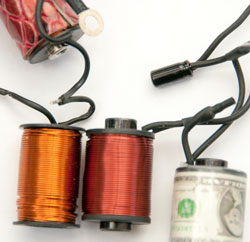
|
|
I also ordered on eBay "Complete Tattoo Machine Kit - 2 Gun
Skull Set" for $12 w/free shipping. It came in a 1
cubic foot box with a bunch of stuff! Way lower cost than
buying parts separately.
In addition ordered "Digital Dual Machine Tattoo Power Supply
LCD Display W Clip Cord &ft Switch P025" which is a tattoo
power supply that displays Voltage, Frequency and Duty Cycle,
but not current (see Fig 4 below). about $40.
Tattoo Machine Kit Photos
Fig 1 Contents of Kit

|
Contents:
2 multi-use tattoo machines with low-vibration frames,
upgraded brass contacts, and dual 10-wrap coils; can be
used for lining and shading
1 pro-quality analog power supply system (US-standard 120
volt power cord)
1 stainless steel foot pedal controller
1 silicone clip-cord with stainless contacts
1 white LED machine-mountable work light
1 high-grade resin skull ink holder, holds up to 7
medium-sized ink caps
4 round plastic tips in sizes 3R, 5R, 7R, 9R and 11R (1 of
each size)
5 flat plastic tips 5F, 7F, 9F, 11F, and 13F (1 of each
size)
3 diamond plastic tips 3D, 5D, and 7D (1 of each size)
20 round liner needles in sizes 3RL, 5RL, 7RL and 9RL (5
of each size)
20 round shader needles in sizes 3RS, 5RS, 7RS and 9RS (5
of each size)
5 flat shading needles in size 5FS
5 magnum shading needles in size 7M1
100 small (#9) ink caps
50 medium (#13) ink caps
7 full bottles of ink by Millennium Colorworks (MOM's)
Inks in 1/2 ounce bottles of the following colors: Black
Onyx Grey Hound Power White Blue Balls Hellow Yellow
Ectoplasmic Monthly Red
1 plastic squeeze wash bottle, holding 8 ounces
1 dual-tip, disposable skin marking pen with fine and
regular tips
75 tattoo machine anti-microbial, heat and UV resistant
rubber bands
75 mixed-color anti-microbial, heat and UV resistant
grommets
50 spare anti-microbial, heat and UV resistant o-rings
3 hex-wrenches for machine adjustment (1.93mm, 2.45mm
(coil, lower electrical terminal & contactholder)
& 2.95mm (armature spring)
5 wire cleaning brushes on a convenient hanging ring
1 single-use packet of tattoo aftercare ointment
containing vitamins A and D
5 pairs of black nitrile, textured powder-free gloves
1 - 8 ounce bottle (COSCO Brand) Tincture of Green Soap
3 - 8.5" by 11" sheets of Spirit 4-ply thermal-style
transfer paper
1 dual-sided and re-usable realistic practice skin Tattoo
Basics instructional eBook |
Fig 2 Tattoo Machines top & bottom
views
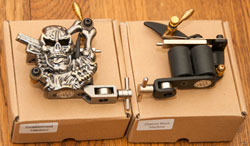 |
Fig 3 The analog supply is labeled:
1.5 to 15 Volts 2 Amps
 |
Fig 4 DT-P025 Power supply displaying: 16.5
Volts, 52% Duty Cycle & 100 CPS.
Can be adjusted from 0.0 to 17.8 Volts in 0.1 Volt steps.
Large knob is digital shaft encoder, not a pot. It
takes many turns to cover full voltage range.
 |
|
|
|
|
464801
Tattooing Machine, Samuel F. O'Reilly, 1891-12-08 -spinning
wheel rather than see-saw bar. cited
by 24 patents.
DC Permanent Magnet Motors
-
Walker Scientific Inc. MG-3D Gaussmeter
(93F Hall Effect probe)
The MG-3D is a digital display instrument
with five full scale ranges from 10 gauss to 100,000 gauss for
AC or DC fields, displayed on a ±0.05% 3-1/2 digit bipolar DPM
offering ±0.1% resolution.
Range
5 Full scale; 10, 100, 1K, 10K, 100K with 100% over-range
Display
TYPE-Digital; ±0.05% plus 1 digit 3 1/2 digit bipolar DPM
RANGE-0.01 to 199.9
NORMAL MODE - For measurement of DC (steady state) fields
only.
RMS MODE - Meter displays the RMS value of the measured field
(AC and DC components). Accuracy is ±1% for measurement of
fields from 3Hz to 10Hz, ±0.3% 10Hz to 400Hz within frequency
response stated.
PEAK READING OPTION - ±0.1% of full-scale range within stated
frequency response
Analog Output
ANALOG VOLTAGE - ±1 volt full-scale Overrange capability to
±10 volts without loss of accuracy. Output is proportional to
the measured field.
ACCURACY - ±0.1% or 10 milligauss, whichever is greater
FREQUENCY RESPONSE - DC to 400 Hz (3 dB down at 400Hz)
OUTPUT IMPEDANCE -100 ohms
LOAD IMPEDANCE - Minimum of 2,000 ohms; short circuit
protected
Power Input
Approximately 6 Watts; .06 amps @ 105V to 125V or .03 amps @
210V to 250V - 50Hz to 400Hz
STANDARD - 115V 50Hz to 400Hz
Helmholtz Coil
Sensitive Research Instrument Co. Fluxmeter
Annis
M25 Pocket Magnetometer
HP 428 Clip-on Milli-ammeter - with both
clip-on probes and a magnetometer
AlphaLab DC Gaussmeter Model 1
AMY6 Magnetic
Polarity Tester
GE
Gauss Meter & Reference Magnet
Sensors - Magnetic - Helmholtz Coil
Telegraph
Telephone - Telephone
patents
Electromagnetic devices:
Build it YOURSELF!, a REAL
ELECTRIC MOTOR
Electromagnetic Toy Engine
Gilbert DC 3-pole Electro-magnetic
Machine
Leclanché Battery - wet cell
MESCO 1011 Toy Engine
No. 6 Dry Cell -
Toy Motor Kit & modern version as
well as Science First demonstration motor -
Vibrators -
Weeden DC 2-pole
Electro-magnetic Machine - really a generator
Magnets - this web page
Magnatometers
Sonobuoys & CRT-1 Sonobuoy
DC Permenant Magnet Motors
Walker Scientific MG-3D Gaussmeter
Wireless Driveway Monitor
- solar magnetometer








